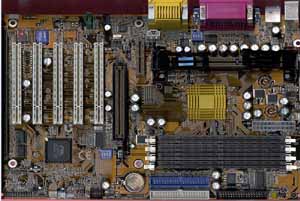Gigabyte GA-6VX-4X Apollo Pro 133A Slot-1 ATX
by Mike Andrawes on March 19, 2000 1:56 AM EST- Posted in
- Motherboards
Although Gigabyte doesn't get the publicity of ABIT or ASUS, they've proven themselves time and time again in the AnandTech lab. Our testing has shown that Gigabyte provides some of the most stable boards out there that and they are also packed with features. In fact, we were so impressed with the GA-6VX-4X in our first VIA Apollo Pro 133/133A Motherboard Roundup that we decided it deserved the AnandTech Editor's Choice Gold Award in that comparison. How does it stand up when it's under the microscope all by itself? Let's find out.
|
Motherboard Specifications |
|
| CPU Interface |
Slot-1
|
| Chipset |
VIA Apollo Pro 133A
VIA 694X North Bridge VIA 686A South Bridge |
| L2 Cache |
N/A (on-chip)
|
| Form Factor |
ATX
|
| Bus Speeds |
66
/ 100 / 112 / 124
133 / 142 / 152 |
| Voltages Supported |
Auto Detect
|
| Memory Slots |
4 168-pin DIMM Slots
|
| Expansion Slots |
1 AMR Slot
1 AGP Slot 5 PCI Slots (2 Full Length) 1 ISA Slot (1 Shared / 1 Full Length) |
| Onboard Sound |
Analog
Devices AD1881 AC 97
Aureal 8810 PCI (optional) |
| BIOS |
AMI Simple Setup 1.20C
Gigabyte DualBIOS |
The Good
For our recent VIA Apollo Pro 133/133A Motherboard Roundup, Gigabyte provided us with two boards that met our criteria - the 6VX-4X and the 6VX7-4X. Both are standard ATX boards that feature the VIA 133A chipset with the main difference being the CPU interface - the 6VX-4X is Slot-1 based, while the 6VX7-4X is a Socket-370 board. Although Intel is moving their entire CPU line to the Socket-370 format, a complete transition is still quite a while off and the Slot-1 interface currently offers more flexibility thanks to Socket-370 to Slot-1 converters, often called Slockets. While both boards performed ahead of the pack, we picked the 6VX-4X to receive the prestigious AnandTech Editor's Choice Gold Award.
Both boards feature a 5/1/1/1 (PCI/ISA/AGP/AMR) slot configuration and use the VIA 133A chipset, but the similarities stop there. First, the 6VX-4X gains an additional DIMM slot, for a total of 4. Although the 694X North Bridge technically supports 8 banks of memory, which is normally sufficient for 4 DIMM slots, the PC133 specifications recommends a maximum of 6 banks, which normally translates to 3 DIMM slots.
Gigabyte's solution - provide 4 DIMM slots for those that would like to push the spec but recommend that only 6 banks of memory be installed (ie if all 4 slots are used, DIMM's 3 & 4 should be single sided modules). Of course since the chipset does support 8 banks of memory, you can use 4 double sided DIMM's, but know that you are exceeding the PC133 spec. The slots themselves are capable of accepting PC100 or PC133 SDRAM as well as VC100 or VC133 Virtual Channel SDRAM. With the latter two being nothing more than vaporware in the market right now, PC100/PC133 memory is really what you can expect to use with the board. The ATX power supply connector is located between the DIMM slots and the Slot-1 interface, which could pose a problem for those using larger heatsinks on their CPU's.
An orange heatsink is attached to the VIA 694X North Bridge with thermal tape. The VIA 694X is the source of the AGP 4X and official 133MHz front side bus frequency support on the 6VX-4X. Unlike the i820 with its RAMBUS interface, the 694X uses an SDRAM memory interface, which is a large part of its huge popularity. The memory bus itself can run at either the FSB frequency, which by default is 100MHz, or at FSB +/- 33MHz which would put the memory bus at 133MHz while the FSB runs at 100MHz. The ability to set the memory bus frequency allows PC100 memory owners to use their memory without having to upgrade to PC133 while at the same time not sacrificing performance for those that do have PC133 memory. For full details on the Apollo Pro 133A chipset, see our VIA Apollo Pro 133/133A Motherboard Roundup and our first look at the VIA Apollo Pro 133A.











0 Comments
View All Comments